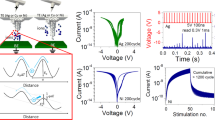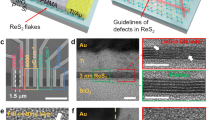Abstract
The implementation of memristive synapses in neuromorphic computing is hindered by the limited reproducibility and high energy consumption of the switching behaviour of the devices. Typical filament-type memristors suffer, in particular, from temporal and spatial variation in the set voltage and resistance states due to stochastic filament formation. Here, we report memristors based on two-dimensional pentagonal palladium diselenide (PdSe2) that can exhibit anomalous resistive switching behaviour with two interchangeable reset modes: total reset and quasi-reset. Heterophase grain boundaries are formed in the PdSe2 via local phase transitions induced by electron-beam irradiation, which leads to residual filaments along the grain boundaries that can guide the formation of conductive filaments. When operated in the quasi-reset mode, the memristors show a sixfold improvement in switching variation compared with devices operating in the total-reset mode, as well as a low set voltage (0.6 V), long retention times and programmable multilevel resistance states. We also show that the devices can emulate synaptic plasticity and that multipattern memorization can be implemented using a crossbar array architecture.
This is a preview of subscription content, access via your institution
Access options
Access Nature and 54 other Nature Portfolio journals
Get Nature+, our best-value online-access subscription
$29.99 / 30 days
cancel any time
Subscribe to this journal
Receive 12 digital issues and online access to articles
$119.00 per year
only $9.92 per issue
Buy this article
- Purchase on Springer Link
- Instant access to full article PDF
Prices may be subject to local taxes which are calculated during checkout






Similar content being viewed by others
Data availability
The data that support the plots within this article and other findings of this study are available from the corresponding author upon reasonable request.
References
Xia, Q. & Yang, J. J. Memristive crossbar arrays for brain-inspired computing. Nat. Mater. 18, 309–323 (2019).
Wang, C.-Y. et al. 2D layered materials for memristive and neuromorphic applications. Adv. Electron. Mater. 5, 1901107 (2019).
Li, Y., Long, S., Liu, Q., Lv, H. & Liu, M. Resistive switching performance improvement via modulating nanoscale conductive filament, involving the application of two-dimensional layered materials. Small 13, 1604306 (2017).
Zhao, X. et al. Confining cation injection to enhance CBRAM performance by nanopore graphene layer. Small 13, 1603948 (2017).
Tsai, T. L., Jiang, F. S., Ho, C. H., Lin, C. H. & Tseng, T. Y. Enhanced properties in conductive-bridge resistive switching memory with oxide–nitride bilayer structure. IEEE Electron Device Lett. 37, 1284–1287 (2016).
Kumar, D., Aluguri, R., Chand, U. & Tseng, T.-Y. Enhancement of resistive switching properties in nitride based CBRAM device by inserting an Al2O3 thin layer. Appl. Phys. Lett. 110, 203102 (2017).
Choi, S. et al. SiGe epitaxial memory for neuromorphic computing with reproducible high performance based on engineered dislocations. Nat. Mater. 17, 335–340 (2018).
Lee, J., Du, C., Sun, K., Kioupakis, E. & Lu, W. D. Tuning ionic transport in memristive devices by graphene with engineered nanopores. ACS Nano 10, 3571–3579 (2016).
Zhao, X. L. et al. Breaking the current-retention dilemma in cation-based resistive switching devices utilizing graphene with controlled defects. Adv. Mater. 30, 1705193 (2018).
Zhang, L., Gong, T., Wang, H. D., Guo, Z. N. & Zhang, H. Memristive devices based on emerging two-dimensional materials beyond graphene. Nanoscale 11, 12413–12435 (2019).
Sangwan, V. K. et al. Multi-terminal memtransistors from polycrystalline monolayer molybdenum disulfide. Nature 554, 500–504 (2018).
Wang, L. et al. Artificial synapses based on multiterminal memtransistors for neuromorphic application. Adv. Funct. Mater. 29, 1901106 (2019).
Prakash, R., Sharma, S., Kumar, A. & Kaur, D. Improved resistive switching performance in Cu-cation migrated MoS2 based ReRAM device incorporated with tungsten nitride bottom electrode. Curr. Appl. Phys. 19, 260–265 (2019).
Feng, X. et al. A fully printed flexible MoS2 memristive artificial synapse with femtojoule switching energy. Adv. Electron. Mater. 5, 1900740 (2019).
Pan, C. B. et al. Coexistence of grain-boundaries-assisted bipolar and threshold resistive switching in multilayer hexagonal boron nitride. Adv. Funct. Mater. 27, 1604811 (2017).
Hui, F. et al. Synthesis of large-area multilayer hexagonal boron nitride sheets on iron substrates and its use in resistive switching devices. 2D Mater. 5, 7 (2018).
Zhuang, P. et al. Nonpolar resistive switching of multilayer-hBN-based memories. Adv. Electron. Mater. 6, 1900979 (2019).
Yan, X. et al. Robust Ag/ZrO2/WS2/Pt memristor for neuromorphic computing. ACS Appl. Mater. Interfaces 11, 48029–48038 (2019).
Ly, T. H. et al. Misorientation-angle-dependent electrical transport across molybdenum disulfide grain boundaries. Nat. Commun. 7, 10426 (2016).
Lanza, M. et al. Grain boundaries as preferential sites for resistive switching in the HfO2 resistive random access memory structures. Appl. Phys. Lett. 100, 123508 (2012).
Zhang, Y. et al. Brain-inspired computing with memristors: challenges in devices, circuits, and systems. Appl. Phys. Rev. 7, 011308 (2020).
Chua, L. O. Memristor—the missing circuit element. IEEE Trans. Circuit Theory 18, 507–519 (1971).
Oyedele, A. D. et al. PdSe2: pentagonal two-dimensional layers with high air stability for electronics. J. Am. Chem. Soc. 139, 14090–14097 (2017).
Lin, J. H. et al. Novel Pd2Se3 two-dimensional phase driven by interlayer fusion in layered PdSe2. Phys. Rev. Lett. 119, 016101 (2017).
Liang, F.-X. et al. Light confinement effect induced highly sensitive, self-driven near-infrared photodetector and image sensor based on multilayer PdSe2/pyramid Si heterojunction. Small 15, 1903831 (2019).
Zuluaga, S., Lin, J. H., Suenaga, K. & Pantelides, S. T. Two-dimensional PdSe2–Pd2Se3 junctions can serve as nanowires. 2D Mater. 5, 035025 (2018).
Zhuge, F. et al. Improvement of resistive switching in Cu/ZnO/Pt sandwiches by weakening the randomicity of the formation/rupture of Cu filaments. Nanotechnology 22, 275204 (2011).
Tsuruoka, T., Terabe, K., Hasegawa, T. & Aono, M. Forming and switching mechanisms of a cation-migration-based oxide resistive memory. Nanotechnology 21, 425205 (2010).
Rehman, S. et al. Thickness-dependent resistive switching in black phosphorus CBRAM. J. Mater. Chem. C 7, 725–732 (2019).
Zhu, J., Zhang, T., Yang, Y. & Huang, R. A comprehensive review on emerging artificial neuromorphic devices. Appl. Phys. Rev. 7, 011312 (2020).
Nicholls, J. G., Martin, A. R., Wallace, B. G. & Fuchs, P. A. From Neuron to Brain 271 (Sinauer, 2001).
Yang, R., Huang, H.-M. & Guo, X. Memristive synapses and neurons for bioinspired computing. Adv. Electron. Mater. 5, 1900287 (2019).
Kumar, M., Ban, D.-K., Kim, S. M., Kim, J. & Wong, C.-P. Vertically aligned WS2 layers for high-performing memristors and artificial synapses. Adv. Electron. Mater. 5, 1900467 (2019).
Acknowledgements
This work is supported by A*STAR Science and Engineering Research Council (no. A2083c0061), and by the National Research Foundation, Prime Minister’s Office, Singapore, under its Competitive Research Programme (NRF-CRP24-2020-050). We thank A. V.-Y. Thean, Y. Li, X. Feng and X. Gong in the Department of Electrical and Computer Engineering, and K. P. Loh and L. Wang in the Department of Chemistry, National University of Singapore, for valuable help in device measurements.
Author information
Authors and Affiliations
Contributions
This project was supervised and directed by K.-W.A. Y.L. and K.-W.A. conceived this work. Y.L. and K.-W.A. designed the experiments. Y.L., S.L. and B.L. performed the device fabrication. Y.L. and S.L. conducted the electrical measurements. Y.L. and L.C. performed the material characterization. L.L. and M.B. performed the STEM-ADF imaging. All authors contributed to the discussion and analysis of results. Y.L. and K.-W.A. wrote the manuscript.
Corresponding author
Ethics declarations
Competing interests
The authors declare no competing interests.
Additional information
Peer review information Nature Electronics thanks Shibing Long and the other, anonymous, reviewer(s) for their contribution to the peer review of this work.
Publisher’s note Springer Nature remains neutral with regard to jurisdictional claims in published maps and institutional affiliations.
Supplementary information
Supplementary Information
Supplementary Figs. 1–21, Discussion and Tables 1 and 2.
Rights and permissions
About this article
Cite this article
Li, Y., Loh, L., Li, S. et al. Anomalous resistive switching in memristors based on two-dimensional palladium diselenide using heterophase grain boundaries. Nat Electron 4, 348–356 (2021). https://doi.org/10.1038/s41928-021-00573-1
Received:
Accepted:
Published:
Issue Date:
DOI: https://doi.org/10.1038/s41928-021-00573-1



